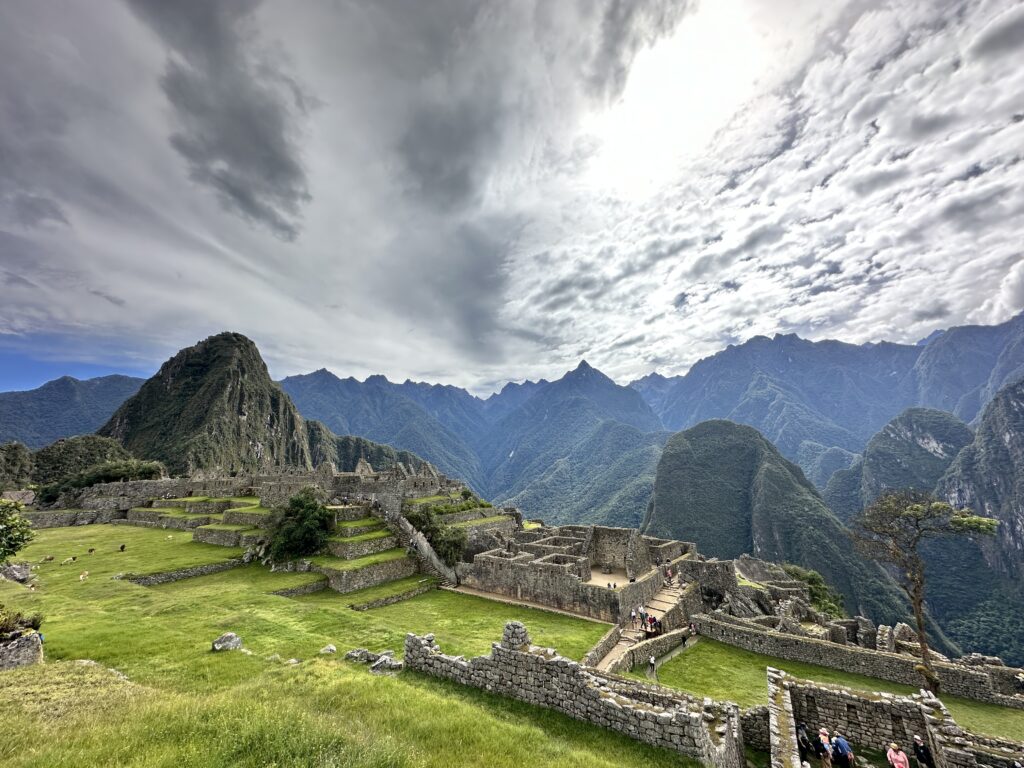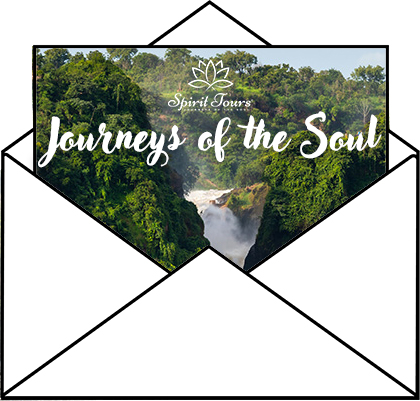
Is this some mystical game of peek-a-boo, I wonder as I gaze down on the sacred, cloud-shrouded site of Machu Picchu. The settlement straddles a mountain ridge about 9,000 feet high in the Peruvian Andes, and as the morning mist skims through the ruins, 150 or so granite buildings disappear and reappear before my eyes. I watch entranced from an ancient Inca terrace overlooking the settlement, which seems to hang in mid-air.
Behind the ruins, towering above them like a verdant god, is a jungle-covered mountain named Huayna Picchu. On either side of the settlement, a series of grass-covered terraces like the one I stand on spill down the steep mountainsides like enormous green Legos until the land simply falls away. Machu Picchu balances cleverly, caught in a precarious dance with earth and sky.
The surrounding Andes reach into the heavens. Easily climbing more than 10,000 feet higher than I am already, they dwarf the city below as they boldly kiss the sun—a god to the Incas who once lived here.
An air of mystery hangs over the site, much like what I’ve experienced in places such as Stonehenge in England or the Mayan pyramids in the Mexican jungle. Although this 500- to 600-year-old stone city is one of the most visited archaeological sites in the western hemisphere (more than a million people visit it every year), no one knows for sure why the Incas built it or why they deserted it unfinished 70 to 80 years later.
Humbled, I wind my way down stone steps that lead to the ruins and walk through a doorway that serves as the surprisingly modest city gate. The narrow streets here were choked with jungle vegetation in 1911 when Yale historian Hiram Bingham became the first foreigner to document the site and bring it international attention. Machu Picchu had then easily been reclaimed by the rainforest, adorned with more than 300 species of orchids in pinks, yellows, and whites as well as even more species of exotic birds—many of which still live here today.

Ever since Bingham’s visit, Machu Picchu has mystified archaeologists from around the world who have tried to turn the site inside out, seeking clues to its purpose and history. Bingham wrongly thought it to be a military defense post. The romantic notion later circulated that this was a spiritual center for virgin priestesses. Other theories pegged it as an agricultural hub, a ceremonial site with an astronomical observatory, or a royal estate for 15th-century Inca emperor Pachacuti (the current deduction).
I am more interested in why it had been abandoned and how it had been kept a secret from the destructive Spanish conquistadors and most of the rest of the world for half a millennium. Archaeologists now think the Incas simply departed after the death of the powerful and revered Pachacuti, although more dramatic theories persist. Some involve a deadly epidemic, others attacks from jungle tribes. My favorite—and the one championed by most guides—blames a lightning strike that cracked a lintel in the Temple of the Sun, interpreted as an ominous sign by terrified Incas who then fled in haste.
Imagining just such a scene, I stop at the base of the P-shaped temple of the sun—about the same size as many of the houses here. If not for all the guides stopping their tours here to point out the structure’s distinctive curved wall, I might well have thought the one-room building too tiny to be a temple, let alone the most important one in town.
One modest second-story window in particular holds my interest. Unadorned, it looks like any other window in the settlement, yet this one is precisely aligned with the sunrise on the June solstice (heralding the start of winter here in the southern hemisphere). As that day dawns, the sun’s rays initially pierce a distant portal looking down on the site from a higher spot on the mountain three kilometers away. A split second later, light streams through this otherwise unassuming opening like an arrow hitting a bullseye. Clearly, the Incas were just as sophisticated in their knowledge of astronomy as were the ancient Europeans and Egyptians who built similarly precise observatories.
After walking down several flights of steps and through more narrow streets, I arrive at a large, flat triangular rock with a carved teardrop shape fitting into one corner, protected by a curved stone resembling a collar. This is the Temple of the Condor, honoring the revered bird of prey that is to South Americans what the eagle is to North Americans. The rock depicts the condor’s head and ruff, while the steep, craggy outcropping behind it suggests wings. This so-called temple has no actual room or chamber, although a narrow passageway winds under this outcropping, past a hole leading to a tiny underground cell—its purpose forever lost in time.
How ironic, I think, that despite all the scrutiny by scores of scientists and countless visitors, this site holds mysteries we will surely never crack. In this Information Age obsessed with knowledge and facts—when anyone can call on Siri or the AI program of one’s choice to access even the most arcane fact (the number of teeth on an alligator or the Japanese word for ridiculous)—mystery can still hold court.
Crossing a grassy plaza, I then make the steep climb up a rocky hill to the city’s highest point. Puffing from the exertion at such an elevation, I catch my breath and then wander through the summit complex toward a sacred stone called the Intihuatana, or “hitching post of the sun.” About the size of a Volkswagen Beetle, it sports funky step-shaped angles and a funny-looking squat pillar popping out the top. Its precise shadows predict a host of celestial events.
The Incas clearly understood that such knowledge is power, a concept with which any successful denizen of 21st-century America might agree. Knowledge gives us a certain amount of control over the world and our lives. It has cured polio, allowed us to travel faster than the speed of sound, and enabled us to have a live chat with someone on the opposite side of the world. What’s more, type-A, linear, logical folks like me feel a certain amount of comfort and security in knowing that twelve times twelve is always 144.
Yet as I wander through Machu Picchu, I can’t help but see that the unknown and the unknowable hold a different kind of power—one that may well be more significant. After all, it’s mystery that feeds our inner poet, our romantic side, our childlike wonder. It inspires us to visit foreign shores, to hunt for hidden treasure, to stay up late debating the meaning of life with friends and lovers.
Mystery gives us something to reach for, something to dream about. Not knowing what is ahead often keeps us going, giving us hope when current situations grow tough to take. And the moment we get even the slightest bit too proud, mystery keeps us humble.
Mystery is downright seductive, enchanting, awe-inspiring. And although awe doesn’t give us a wink of control over anything, it does make us feel like a five-year-old on Christmas morning. It makes us glad to be alive in a way that knowing the capital of Pennsylvania, or the square root of 196, or the exact spelling of facetious never could.
Pondering all this, I start to search for a spot far from the cacophony of tourist chatter, guide spiel, oms from chanting pilgrims, and whistled warnings from guards shooing overzealous visitors out of off-limits areas. Heading for an out-of-the-way corner where I can appreciate this Inca masterpiece in peace, I wander down some steps and across a lonely terrace at the very edge of the site.
I’m surprised to find out here, in the middle of what I thought was nowhere, a finely worked doorway and window. Doubly odd is that they don’t lead to any sort of normal room but to a small cave-like space that is hardly big enough to stand in. I see no other carvings, no steps, no niches, no evidence of anything but wet, moss-covered rock and damp earth in the far corners. It’s a door to nowhere—for the moment, an enigma.
Later, I would learn that the “cave” is called Intimachay. Its window is aligned with the sunrise on the Southern Hemisphere’s summer solstice in December. Not coincidentally, the Inca creation story holds that the first Incas emerged from a cave with windows during the summer solstice. I relish the chance to discover this space alone and to feel the weight of its sacredness before knowing anything at all about its history or purpose.
Closing time is near, so I reluctantly join the other visitors as we pick our way toward the exit. En route, I stop by a crumbling doorway to watch twin lizards posing like sentinels on either side of the entryway. Spooked by something I don’t see, they break formation, scrambling over the stone blocks and hiding in the fissures. The lizards remind me of the site’s mysteries, very much alive but hiding in the cracks of the ruins.
We may never be able to answer all the questions about this place, I realize, but perhaps that is Machu Picchu’s gift—permission to let go of our need to know precisely why and how and who and to instead revel in our wonder and in the mystery of our universe itself. After all, Albert Einstein deemed the mysterious to be the source of all true art and science. And wonder is at the heart of everything we hold sacred. It connects us to the Divine—the Great Mystery itself. What more powerful a gift can there be?
About the Author

Katy Koontz is a longtime freelance writer, author, and editor whose work centers on spirituality, travel, and mind-body health. She is editor-in-chief of Spirituality & Health: A Unity Publication and formerly held the same role at Unity Magazine. Katy was named to the 2019 Folio: 100 list for editorial excellence, and her writing has earned honors from the Folio Eddie Awards and the Lowell Thomas Travel Journalism Awards of the Society of American Travel Writers. Learn more at katykoontz.com.

We Love Meeting New People
Kindred spirits find each other through sharing. When you invite friends to explore our Journeys of the Soul newsletter, we’ll thank you with meaningful rewards for growing the circle.
